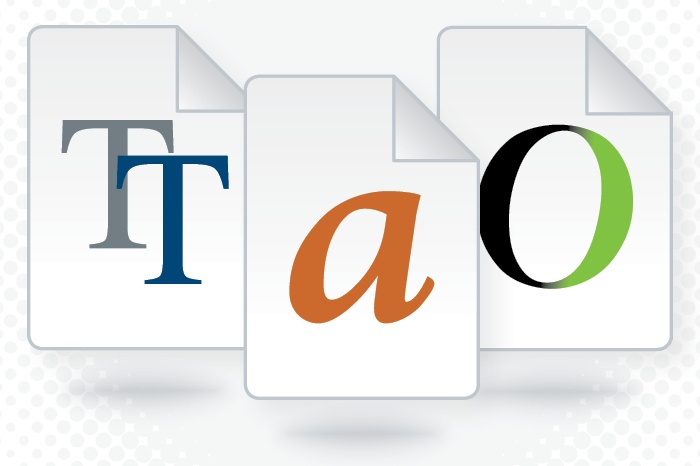
The differences between font files can get very technical, each has a list of pros and cons based on how you plan to use them. Most people don’t need a deep comprehension of these file types, just a basic understanding in order to work with their printer, web developer or graphic designer. This blog is meant to serve as a simple guide to ease font file confusion.
Before you can recognize which font file type is right for you, it is important to understand what a font is. A font is a graphical representation of text that may include a different typeface, point size, weight, or design. Although the term font first referred to a set of movable metal type pieces in one style and size, since the '90s it generally refers to a set of digital shapes in a single style.
A font family or typeface refers to a collection of related fonts. For example, Helvetica is a typeface and Helvetica Italic is a font. Each font within a typeface will come with its own file, but which file type do you need?
Two types of font formats
Computers and devices display fonts in two ways, bit-mapped and vector.
Bit-mapped font (or raster font):
Every character is represented by an arrangement of pixels. These fonts are faster and easier to use in computer code, but they are not scalable, which requires a separate font for each size and style.
Vector font (or scalable font):
The outline of each character is defined geometrically. This allows a font to be scaled to any size using a single file, but requires additional code to render the font for screens.
The different font file types
Over the years there have been several font file types created, each for a specific purpose. I’m going to cover the ones that I encounter on a regular basis as a graphic designer, both for print and web use.
PostScript
PostScript fonts were created by Adobe. They have two different parts, one that contains information for printing and one for screen display. They are great for high quality printing but a drawback is they are not cross-compatible, meaning there are different versions for Macs and PCs. This can lead to a lot of issues when multiple people need to handle a file. A PC font opened on a Mac computer will not look the same if opened on the PC. PostScript fonts are also often referred to as Type 1 Fonts. Since the creation of OpenType fonts, the use of PostScript fonts has dwindled significantly.
TrueType (.ttf)
TrueType is a font format that was developed by Apple and was eventually licensed to Microsoft. They only require one file, but a separate file needs to be added for each instance of the font (regular, italic, bold, etc.) TrueType fonts can be unreliable for publishing so traditionally they were used for viewing on-screen, and PostScript was used for printing.
OpenType (.otf & .ttf)
OpenType is a newer font type built on the TrueType format that supports an expanded character set (smallcaps, ligatures, glyphs, and alternatives inside the font instead of separate). OpenType fonts were created by Adobe and Microsoft, and offer cross-compatibility. They are ideal for graphic designers and desktop publishing software like InDesign, offering outline and bitmap data for the font in one file. At Suttle-Straus, we recommend using OpenType whenever possible.
Web Open Font Format (.woff)
Web Open Font Format (WOFF) is a format that's used on web pages. It works just like TrueType and OpenType, but since it's compressed it will make your content download quicker. Currently all browsers support WOFF. Often font vendors don't want to license their TrueType or OpenType format fonts for web use, but they'll license WOFF.
Note: You may have come across Typekit fonts in recent years. These fonts are available as a resource for Adobe Creative Cloud users. It is a library of OpenType fonts that are available for sync and web use (for as long as you have a subscription), but you do not have access to the font files. That means that you cannot share these fonts with your client or printer, they would need their own subscription.
As a graphic designer, these are the most common font types that I come across, but there are more options—for example, web developers use different files in order to provide quality and consistency across all operating systems and web browsers. If you are dealing with a font file not covered in this blog, I recommend reaching out directly to your printer, web developer, or designer.
Note: There are multiple font file conversion software options available, free online versions and some for purchase, that can convert fonts to different file types.
With so many font files, there is no one-size-fits-all, but with the right understanding you will certainly be able to find the perfect file for your current project!
Sources
http://www.webopedia.com/TERM/F/font.html
https://en.wikipedia.org/wiki/Computer_font
https://www.pluralsight.com/blog/creative-professional/differences-between-font-formats


